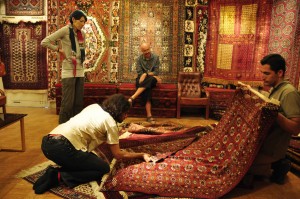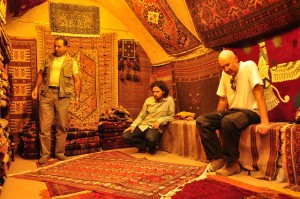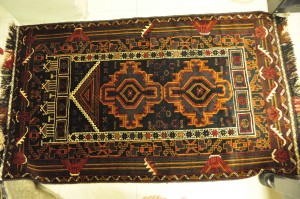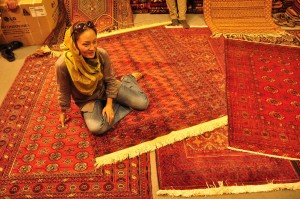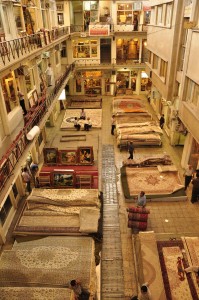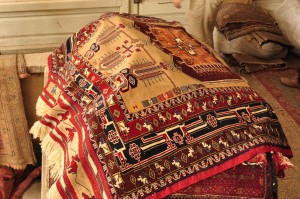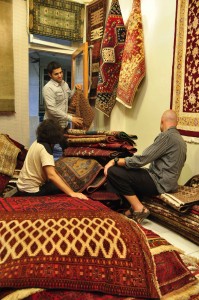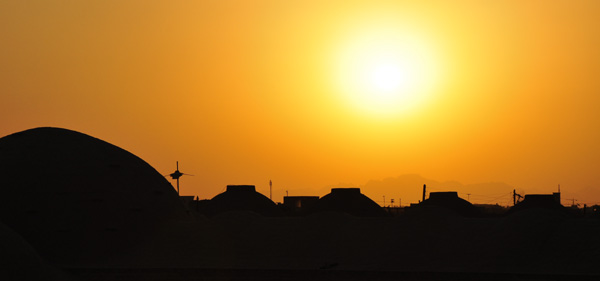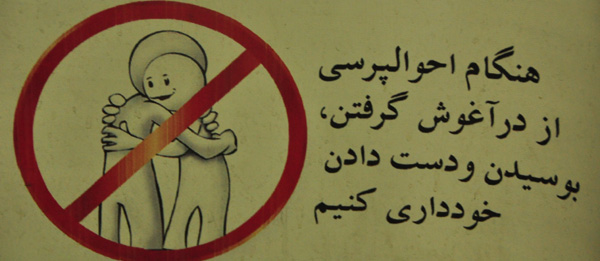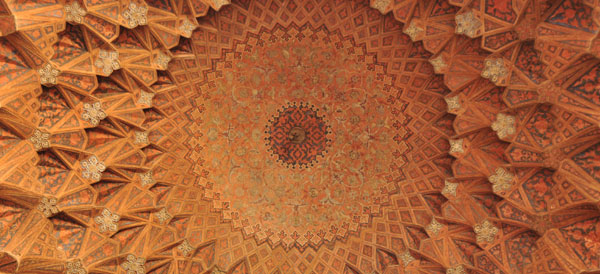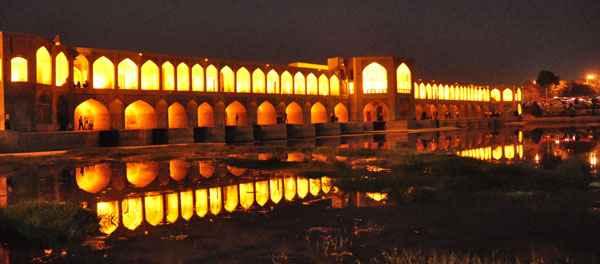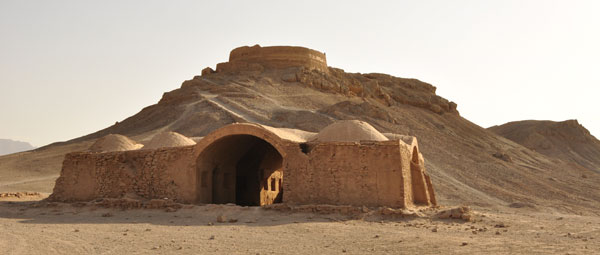I have tried (rather ambitiously) to outline the overall experience of the Middle East in a single post here. I have done so, in part laziness perhaps, but more to try and create a sense of continuity or flow to the whole adventure, which is certainly how it felt for us. Where possible of course I will break out the key highlights into separate posts with more detail, so do bear with me!
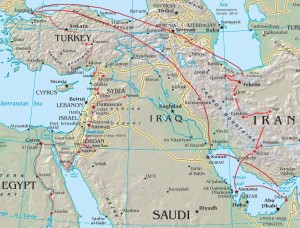
Our journey through the Middle East
After Africa, the Middle East was intoxicating, from the wilds of nature to the heights of ancient civilizations, the contrast couldn’t have been more stark or indeed welcome. It was ridiculously hot though, as an Australian I should know better than planning to wander around a place in 40 to 50 degree heat. In truth, I had started with a cunning workaround for the Middle East – spring, but an extra week here & there, another month or so in India and suddenly we were more than 2 months behind schedule and waddyano arriving slap, bang in the middle of summer. ‘Off season’, as its called here, basically because everyone else knows its’ ridiculously hot and stay away, did certainly make things a bit cheaper though and for the most part less crowded, so there were some perks to go with the sweat, sand & lethargy.
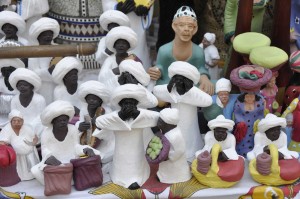
Everything's just a little different
We were gearing ourselves for our arrival in Egypt, every traveller we met ‘coming the other way’ so to speak, warned us of the touts, ceaseless harassment, scams and hassles. Almost typically though now, we failed to encounter any of it – perhaps the African and Indian legs of our adventures had upped our immune system and tout tolerance to some ultra, advanced level so that everything appeared weirdly normal, or more simply that we were so grateful to be back in the zone of ‘civilization’ we barely noticed; either way it was an altogether pleasant letdown. Cairo turned out to be fascinating in its way – aging European in its downtown construction along the banks of the Nile, peppered with gardens, parks and nice hotels. By day, it was baking hot, dusty, noisy, chaotic traffic and seemingly empty of pedestrians, but truly came alive after sunset. As dusk sets in, the downtown streets pulse with a festival like atmosphere; Egyptians roam the sidewalks in their thousands perusing the endless window displays of plastic manikins advertising chadors, head scarfs, kids clothing, jeans and lingerie. While either side of the Nile, families, courting couples and groups of teens meander arm in arm soaking up the evening breeze and posing for photo’s. Everywhere side alleys teem with street eateries, tables, chairs, tea, backgammon and waterpipes.
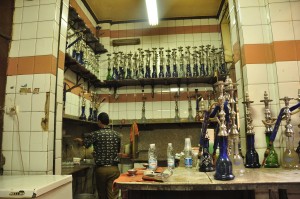
You are never far from a sheeshah!
Everything is open til at least 1am here, with young kids happily playing in the streets alongside the adults right up until the shops close. We spent several days simply walking around, soaking this up, so liberating after the confines of Africa. In the cities of Africa, darkness quickly takes on the feel of a demilitarized zone, even by day most streets are off limits and teeming with the threat of violence. Here we felt immediately safe, barely hassled except by the odd friendly greeting, the darkest alleys held no real threat. For me this is an essential component of travel, the ability to explore on foot, meet people and understand a place at street level, take that away and your experience of a place becomes fleeting, sterile, packaged even. Equally, there was an immense satisfaction in these new Muslim environments from the ability to just randomly slump into a sidewalk chair after a day of wandering about and order up ‘2 hookers with some coke’ and not even warrant a second glance from the young, eager staff. Somehow it just doesn’t seem to get old!
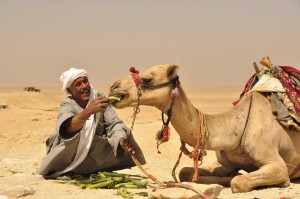
And the camels are everywhere!
Underlying all of this of course was a new Islamic presence – everywhere women are covered head to toe, rarely do you see a woman’s hair in Egypt (except for the tourists at least). At minimum there is a scarf covering the head, with a white or black hair net underneath, certainly no arms or legs on display and at maximum a full black chador with only two slits for eyes and gloves. It certainly set the benchmark for the Middle Eastern experience; we found few other places as conservative as this. Mosques dot the skylines in all directions, with the grandest in old Cairo around the great souq / market. Although I have somehow evolved the ability to sleep in heavily over the years (now suddenly useful), Megumi awakes with the first call to prayer at 5am. And the subsequent day is peppered with the resounding repeats through the ever omnipresent loudspeakers for the morning, lunch and evening renditions. Accordingly people stop, close their shops and disappear in their respective directions for their prayer efforts. Green carpets suddenly fill the alleys and barefooted men, ablutionblocks mysteriously appear, previously unnoticed or dismissed as fountains as barefooted men go about their cleansing. At first this is disorientating – nothing seems open when you need it. But after a few days, you adapt to the rhythm and adjust to the routine that Muslim life necessitates.
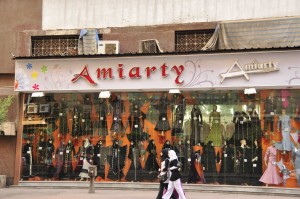
Chadors' Cairo style, a million shades of black
Then amongst all this of course came the World Cup, the Egyptians (and the Middle East) is especially nuts about football, as just about everywhere is of course (outside India, the States & Australia anyway). Suddenly the entire days schedule seemed to fill up. After lunchtime prayers comes the first game at 2.30pm, followed by evening prayers and a second game at 5.00pm, before the final game of the day post evening prayers around 9.30pm. As a result all functional accomplishment seemed to rightly disappear with the heat, most particularly in the evening, as the streets filled with chairs and sheeshahs, all universally pointed in the direction of a TV. We were quite happy just to be carried along with it.
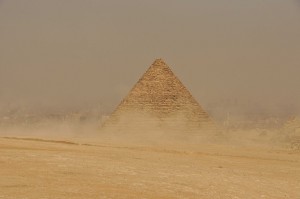
One of the Giza Pyramids in the desert dust
After the essential pharaonic explorations in Cairo and up the Nile to Aswan & Luxor, we journeyed by bus from Cairo down to the Sinai region and ultimately Dahab. A journey that crossed the Suez canal (an anti-climax) and along the arid shores of the Gulfs of Suez and Aqaba; then upon entering Sinai proceeded to be bogged down with innumerable security stops and checks. I seem to remember at least a dozen occasions that a young, smartly dressed Egyptian guy packing a piece, got on the bus and worked through each passengers’ passport or ID. On other occasions a road hump and street block worked the bus into a controlled traffic channel so that papers & vehicles could be expected. Terrorist bombings targeting tourists in this region (the most recent a couple of years back) have ensured such a close lock down, but it was still quite unexpected. Two young Egyptian guys in the seat in front of me actually got pulled off the bus – their national ID cards casting enough doubt around for some further questioning. It was also the first time in our travels that I have seen real military presence & weapons build up. In parts of Asia, India and Africa you almost get used to men standing around with machine guns on every corner. But several times on the side of the road we passed tank & armoured car divisions, the largest some 30 odd tanks neatly lined up ready for deployment. Somewhat guiltily, it excites and tickles the adrenaline all this stuff – too many war comics, computer games and action movies as a kid I guess.
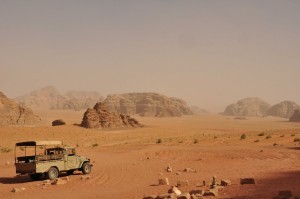
Desert adventures in Wadi Rum
Dahab is a curious place, once a tiny Bedouin camp in the desert it has evolved from hippy haunt to tourist mecca attracting all range of folk and budget travellers. Restaurants, hostels, pensions and trinkets peddlers line a thin strip of shallow coral, where the ocean drops off into a deep trench. It’s a pleasant enough place to relax, though if you don’t fancy camel rides in the desert, apart from climbing Mt Sinai and visiting Katherine’s Monastery (ie the site of Moses’ burning bush) or diving there was little else to do. (which is probably the point actually). We had heard that the Red Sea is some of the best diving around, but while it was enjoyable it didnt match the splendour, colour and diversity of Australia or Thailand, though perhaps I have been a bit spoilt here. In all I found Dahab, a little too touristy, it felt like it was trying too hard to be a ‘Thailand clone’, albeit short on trees and good food. Mind you, we have left the whole ‘holiday mode’ a long way behind us now, so perhaps we were just struggling to relate to the myriad of Russians, Brits and Europeans on their 2 week sabbaticals.
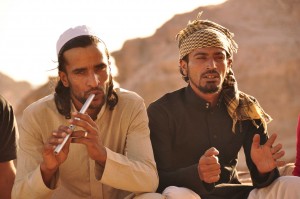
Bedouin musicians in Petra
From Egypt, we crossed the Red Sea by fast ferry to Aqaba in Jordan – the Ferry was fast in operation only and we ultimately boarded some 5 hours late. Although while waiting in the large departure shed, we did manage to befriend an Irish, Polish and Chinese crew, bonding during the tedium of our shared adversity and who generously gave us a ride to Petra later on. Crossing the border by boat was not that interesting; visas and stamps were all collected on board the funky, cruise ship that also featured a fascinating assortment of Duty Free shopping obviously not targeted at the traveller market that made up the ships current consignment. (ie pots, pans, stereos, televisions, irons, washing machines).
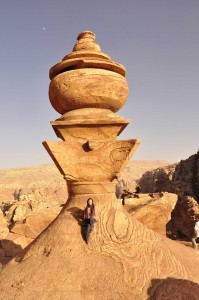
Monastery roof overlooking Petra
Petra was amazing and worth another post in itself. Like the pyramids it was one of our key pilgrimage goals for the Middle East and everything we expected really. The entry to the secret valley through the 3 km winding carved rock channel to first view the great treasury building is exceptionally memorable. We ended up spending 3 days there exploring the ruins til late in the evening, meeting Bedouin lads and other fellow travellers. Without a doubt the highlight was an hour’s climb up the mountain past the main sights to the Monastery for a sunset. Here a friendly collective of Bedouin ran café’s overlooking spectacular viewpoints and sat around playing beautiful music on flutes and lyre and escorting us up secret paths to the Monastery roof. It was magical in every respect and quite ingratiating. We found the Jordanians – Bedouins and Palestinians to be genuinely warm, welcoming, liberal and relaxed, noticeably different from the Egyptians. We then followed that up with an overnight stay in Wadi Rum a 1 hour share taxi away, which is how Jordan seems to operate transport wise, soaking up the sublime landscape and some Bedouin hospitality with a tented camp in the desert. An experience shared with another Irishman we had befriended atop a rock at the Monastery and an Indian woman on leave, while her husband sat for a Doctor’s exam. As fascinating as DH Lawrence’s playground, the desert Bedouin and the landscape was, one day was enough in the heat and we headed onward to Amman, an entirely modern city, where we spent a night, doing little more than watch football with some locals before heading onto Syria and Damascus.
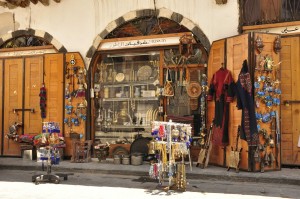
Random bazaar shop in old Damascus
Damascus was one of the real highlights of our trip so far. After securing our Visa’s (Syrian was one of our most interesting experiences yet), we arrived mid afternoon and checked into the Al Rabie hotel, a beautifully restored old Damascan house with a large shared, open courtyard and pleasant rooms, then set about exploring the old town. Damascus lays claim to being the oldest continuously habited city (though it seems every country has one claim to this mantle in the Middle East) and the place teems with a labyrinth of landmarks, historical sights, pilgrims, shops and culture. Old Damascus is a curious mix of Sunni & Shia Muslim pilgrims, Christians and tourists; it shares space with ancient roman ruins, mosques with sacred Muslim sights (including the Prophet ‘John the Baptists’ head & Immam Reza’s tomb), along with Christian landmarks (ie the location of Paul’s conversion and escape); there are also palaces, forts and beautiful old houses here, all adorned with their quirky variations on the ‘copper hand’ doorknockers. But it is the markets and café’s that are most bewitch – The bazaar an intricate network of beautiful wooden doors, paved alleys all heaving with Damascus’ famed inlaid handicrafts, metalwork and fabrics, complimented nicely by the plethora of interesting café’s and restaurants scattered throughout and seemingly hiding around every corner or alleyway. It’s simply an amazing place to explore; the food fantastic & the Syrian people incredibly friendly and welcoming; a long way from the terrorist sponsoring underground of popular fiction. Damascus also coincided with the chance to reconnect with Lindz & Catie – fellow trekkers we had met in Nepal. They had come down via Iran / Iraq and Turkey, so we had plenty of catching up to do and information to trade for which we managed to raid a bar in the Christian quarter to happily facilitate!
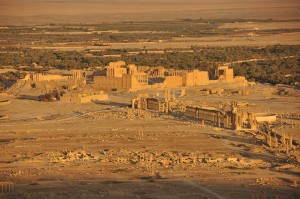
View of the Palmyra ruins at Sunset
Dragging ourselves away from Damascus we headed out along the road to Baghdad for Palmyra, and its stunning ancient Roman ruins close to the Iraqi border. Amazingly we had the whole place to ourselves (actually not really so surprising in the 50 degree heat I guess) and little competition for food or hotels. I also ended up watching a world cup quarter final with 50 other local Syrian men at the only place showing the game in town. Heading back inland, we passed a jet fighter base; each plane spectacularly silhouetted under its own bomb proof hanger roof, the surrounding network of hills was peppered with a beehive of deep bunkers, missile defense systems and sophisticated radar gear, as a spectacle it was almost more exciting than the ruins.
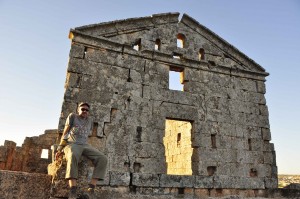
Ruin riding in the Dead cities
Leaving the desert behind, we based ourselves at a small town called Hama, famous for its network of large wooden windmills (there are almost 30 of them) called Noria’s that line the river and once used to channel water for the town. Some of the windmills are up to 1,500 years and as these babies turn with the water, they make a deep, eerie double base-like melody. Alongside the river, the entire town seems to reverberate with its melancholic rhythms. “When they stop”, a local told me,“ no-one can sleep here, it’s as though its’ the towns heartbeat”. In Hama, we connected with an English couple and an American woman (one of the few with a Syrian Visa) to explore the captivating nearby castle fort of Crac De Chaveliers as a day tour (booked through the hostel) and on a subsequent day, the Dead Cities, a tiny sample of some of the 700 stone village skeletons that litter the region, all strangely abandoned some thousand years before. We then spent a day getting lost in the souqs of Aleppo, the largest bazaar in the world and while not quite on a par with those of Damascus, we did take the chance to stock up on some of Aleppo’s famed olive soap before dashing across the border to Turkey.
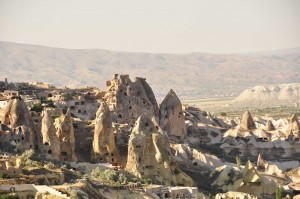
Some Cappadocian Faerie towers
After a brief, enforced schedule stop in the pretty border town of Antakya, we made our way to the stunning Cappadocia region in central Turkey. Arriving in Turkey was for us a ‘return to the first world’ after a 4 month Hiatus, the first time since South Africa probably that we were in a country that bare skin & uncovered heads abounded, shopping brands were familiar and many other creature comforts long forgotten, slowly could rear their heads to grateful recognition. Cappadocia and specifically Goreme, where we were based, was magical. The sculpted, hollow basalt towers, valleys and underground cities that define it, easily occupied several days of relaxed, but intrepid adventuring. Continuing onto Istanbul, we bypassed the rest of Turkey for the moment (it is more European these days anyway), rushing to connect with a flight to Dubai (via Kuwait) in order to meet up with Victor & Yuko (friends from Japan) ahead of exploring Iran.
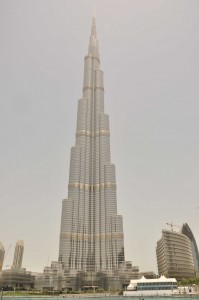
Tallest tower in the world - Dubai
Dubai was fascinating in itself. After exploring the ancient Middle East, seeing the regions most ambitious variant was a great counterbalance and poignant moment of pause to add to our experiences. Almost a more conservative local Muslim society than any other we have been to, the scale, architecture, ambition and almost insanity (rapidly being proved by its bankcrupcy) of the Emirates is something to behold. Not that there is a lot to do here; we explored endless air conditioned malls, climbed the worlds tallest building and found our way to Atlantis, a Disney style water park located at the very palm fronded-end of the man made miracle that is the Palm shaped Island resort (1 of 3). Dubai is a place, desperately trying to be relevant. Enshrined in its innumerable, albeit largely empty office towers there is an audacious lure to the world’s elite companies trying to plug an economic hole. While the malls, hotels and amusements serve to placate, tempt and distract the wealthy local population and tourists alike. Wajid and his wife, friends of Victor played fantastic hosts to us during our stay here and while there is no escaping the resultant hole in the wallet that Dubai aims to provide, it did prove a fantastic base to reconnect with old friends and witness an ‘other side’ that we had necessarily been avoiding in our budget driven country selection criteria’s to date.
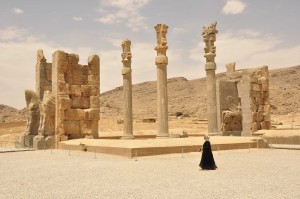
The ancient ruins of Persepolis
Jumping a plane to Shiraz (via Bahrain) with Victor and Yuko, we then set about exploring Iran. As a group of 4 people, we were almost our own tour group and while it took a little while to align pace and style, it came as a welcome change to our usual, isolated random adventuring, not least because I had a carpet buying buddy! Iran itself defies all those preconceived stereotypes and notions, unwittingly forced on us by a relentless western media fuelled (literally) with ulterior motives. In reality, it is a highly modern, liberal and socially vibrant place, its people easily the most welcoming and friendly we have experienced anywhere in our travels. Far from the black cosseted images of the TV, Iranian people (outside the Mosques at least) are largely dressed in a Western fashion and are quite happy to speak their minds. The strict head covering laws are cursorily adhered to with scarfs precariously balanced on the back of the head; freeing up space for a wide range of dramatic fringes, coupled with fashionable, clinging trench coats. It exists in stark comparison with the other more conservative worlds of its Middle Eastern compatriots. Iran has more of a socialist feel to it vs the Arab world; more of a middle class society, with the sort of shared facilities that would be the envy of most countries; free cold water everywhere, incredibly cheap transport infrastructure and clean, fantastically maintained public facilities. Immediately the place welcomes you and enchants, simultaneously birthing ‘an immediate questioning’ of the inherent Western programming and ideas that you see compromised in front of you. In this way Iran was similar to my first encounter with Moscow and more recently those of Syria and Myanmar. This surprise, questioning factor is what makes travel so remarkable I think and creates truly treasured experiences.
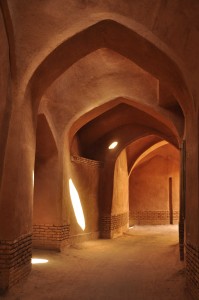
The mud alleyways of Yazd
From wandering the pleasant congenial bazaars, museums and mosques of Shiraz, we explored the ancient desert remnants of the original ‘paradise’, Cyrus the Greats’ former palace in Parsegard and the Persian empires’ subsequent crowning glory, the architectural marvel of Persepolis. After becoming ‘star attractions’ at the Shiraz bus stop (there really are few tourist here), we made our way to the sacred, desert city of Yazd. A truly unique mud brick city, parts of which that wouldn’t be out of place on a Star Wars set, Yazd is famed for its sacred Mosques, Zorastrian sky burial towers and an urban skyline of wind cooling towers. Staying at the Silk Road Hotel, a classic, traditional Iranian house with a large open courtyard and (uniquely in Iran) a somewhat varied (ie non-kebab) cuisine, we explored the numerous mud alleys, bought some (Zorastrian) carpets and soaked up the unique location and architecture.
From there we bounced to Esfahan, my favourite city in the Middle East by far. Magical mosques, enchanting markets, tea-houses, parks, bridges and simply the friendliest most welcoming people I have met anywhere. Perhaps our most defining experience of Iran was experienced here, during a sunset over the Khaju bridge, one of many ancient bridges that line the river and parks in Esfahan. As the light set, the arches under the bridge played host to a variety of beautiful candle light talents, as men (young and old) took turns to recite poetry, dance and singing traditional folk songs to the gathering crowds of locals; picnicking, socializing and enjoying the parks in their thousands, as they do quite religiously everywhere in Iran. It was a true cultural and artistic embrace, the like of which you would struggle to match anywhere first world I think – this must be what happens to societies left to their own devices; devoid of good TV or computer games!
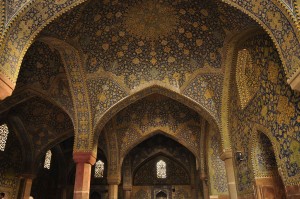
Mesmerising Mosque ceilings in Esfahan
From Esfahan, we enjoyed a strange overnight adventure in Quom, the holiest city in Iran and HQ for many of the Ayatollahs, Mullah’ s and clerics of the Islamic regime. Arriving here was easily the most surreal experience of the journey, our alien nature was never more acutely obvious than in the faces of the thousands of black covered Shiite pilgrims as we hauled our backpacks across the square to a small Arabian hotel, full of Iraqi and Saudi pilgrims. This we contrasted with 2 days staying in remote Ghakor Khan, a tiny village hidden in the spectacular Alamut Valley mountains and a great place to break the heat. The Alamut valley is home to the famed ‘Castles of the Assassins’. The veritable ninjas of the Middle East, these ancient Persian magicians were famed for their use of opiates, strange witchcraft and animist rituals, as for hire assassins. There are about 50 ruined castles that dot, the bare, bleak mountain ranges cliff tops here and its easy to imagine that time into being. We climbed up to the one of the most famed castles above the town, for a sunset, while the castles are quite ruined now, destroyed by Genghis long ago, they still echo with wonder and provide for magnificent views over the surrounding valleys and hills.
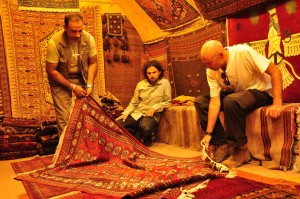
With Victor & the serious biz of carpet buying
Our final Iranian stop was Tehran, here we again braved the huge Bazaar and picked up some exotic nomadic carpets and soaked up many of the sights on offer. Tehran was not nearly as chaotic, crowded, polluted or unpleasant as I had heard. The subway is more like Tokyo, there are great parks, fantastic monuments and museums showcasing the wealth of the Shahs and rich Persian (and most human) history. Amongst the very fashionable, sexy locals there is also a strong vibrant artistic scene, strangely echoed by the fantastic ‘side-of-a-building’ Islamic propaganda artworks that appear on every corner. Of course every big city has a dark side and Victor lost his camera to a motorcycle ‘snatch and grab’ job, that while devasting in its photo loss, was still captivating in that several riders immediately pulled up, told him to jump on as they tried to give chase to the bandits. I’m not sure where else that would occur.
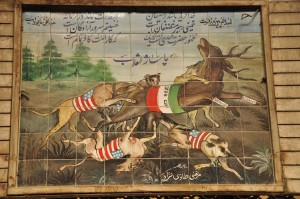
Fantastic anti-US propaganda pieces abound
After saying sad farewell to Victor and Yuko however, we returned to Istanbul. Happily basking in the experience and soaking up our return to civilization, we were back in the once again foreign land of bare skin, tight fitting clothing and international cuisine. The Middle East has been a fantastic experience for its difference, often unexpected. Old cultures, history and values, so strong and vigorous, some of the safest, most friendly and welcoming people in the world; amazing quality handicrafts, bazaars and sublime architecture and for the most part, good food! As the first world kicks back in again with its’ me first agenda, I realize I will miss the honesty, respect and integrity afforded people in Muslim society. There is much more than a shared history that these people offer us and I feel infinitely better for being able to shake off (for good I hope) many of the stereotypes that have been unwittingly thrust my way. Europe is next and should prove quite the contrast!
![On Buying Persian Carpets When we first started our trip, I had a little mental list (and budget set aside) for a few things I intended to pick up […]](http://meltingplots.com/wp-content/uploads/2010/07/Top2.jpg)

